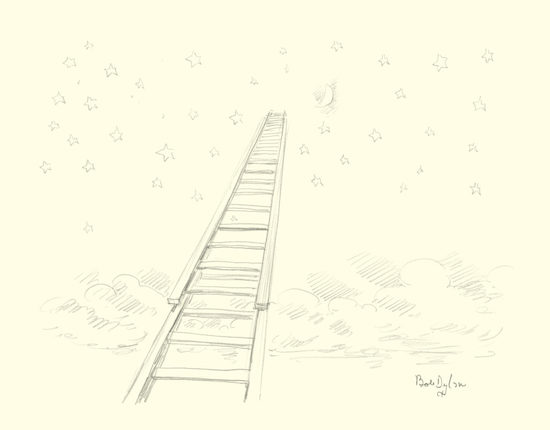On New Bond Street, three smart shop assistants in belt tied aprons were handing out small squares of rose and apple soaps. At first we thought they were sweets, possibly Turkish delight, as we were in a world a candy – candy for the teeth, candy for the eyes – and it was rich, expensive and all about the presentation.
It was late evening. Artist and theatre designer Riitta Haikkarainen and myself were wandering the West End, looking for an interesting exhibition. As a someone interested in Bob Dylan since my boyfriend at college had played his LPs into the night, particularly Freewheelin and Highway 61 Revisited, I wanted to see what his visual art was like. Lyrics and drawings, the show said, so we went inside the dark red space, to see the coffin bordered lyrics and drawings.
It was like he was already dead.
This was a midtown crematorium with notices from the deceased lit up respectfully like soft lamps leading to the body of the deceased. The atmosphere was cushioned, absorbing the sound in the deep dark blood shadows. Lyrics, supposedly made more interesting by being written by hand on cream paper, were displayed next to pretty awful Sunday art of landscapes and figures. No added value to the songs that had forged young America. In fact, with every stroke of the pencil, I felt that value was being taken away from those majestic songs.
I am part of an internet writing forum centred on St Edmund Hall, Oxford, that had welcomed Bob Dylan as a Nobel Prize winner for his lyrics. I argued with those who like to argue about such things that I wasn’t going to join those wolves of language baying against giving a prize for literature to a mere songwriter. Those songs had impressed me. The use of stream of consciousness, his filter of contemporary media, his youthful bile, his nasal punch. I had got all that.
But I did not need to see those songs framed by convention in this schoolish pen. The carefully copied lines were spells that were sucking the blood out of his imagination. And the pictures added no value. In fact they nailed down the sprawling imagination of horses, light landscape, revolution, solidarity, freedom, the urge to kick the hell out of the institution and forge a future, the need to pick your guitar up and hop hobo-style onto a freight train and shimmy across state borders chasing the ghost of Woody Guthrie. They nailed down his long, sprawling sentences in which anything could happen, intimate, vast, wild, romantic and insufferably independent. They bashed and killed and hit and killed and pinned it like a new crucifixion onto badly realised cobble streets, the stones drawn out one by one by a man carrying out a mindfulness exercise.
This was a funeral. With every second I stayed inside this mausoleum of his music, his body of work lost a little breath. My youthful idol was curling up and dying. I didn’t want to see the back of all my dreams and headed up the stairs to the altar of cinema, where I might catch his appearance on screen and refresh my belief.
No good. It was (of course, what else would it be?) a tiresome eulogy, a lifeless rockumentary. I could only bear a couple of seconds then I was pushing my way back out through the curtains.
What an insult this exhibition was to me as a (former) fan. I needed to hit the open air with Riitta. Have I seen Gina Lollobrigida’s sculptures? Asked Riitta. I hadn’t. Riitta described them. Images of the acros made monumental through material. Expensive, huge, in bronze – as she could afford it with fame and money.
Riitta felt insulted by the indulgence that a famous actor could buy a place in the art world. Later, I read online how the sculpture is a magical gold mirror for Lollobrigida. And I see she has brought to life, or rather immortalised through these huge pieces the heroines played by her in the movies. Esmeralda, the Queen of Sheba and Paolina Borghese… but to be honest, I was expecting worse.
Dylan’s exhibition had set me up to expect much worse. It was that bad.
There are a few musicians that make art that get away with it. Don Van Vliet, best known as Captain Beefheart, is greatly admired for his expressionistic, primitivist art. His scrappy, sloppy, gestural paintings add energy to his legacy for me, although in fact they don’t necessarily need to be connected to his music. They encapsulate a looseness, a desire to leave the roles and burn all bridges, urges that are kept under tension in his tight bullying musical motifs.
The cover to Doc at the Radar Station impressed us as reprobate young artists in Forest Gate, with the scruffy black blacking out half of the original pictures. Looked to us like mistakes had been made and the black ink just covered over them, but the resulting image is still compelling – more so because it wipes out half of the two cartoon faces beneath.
As art school musicians, Beefheart was the main influence on a certain circle in Forest Gate focused on the rattling, staccato, springing guitars and drums of the Kenny Process Team.
The Bonzo Dog Doo Dah Band set up what’s now a cliché, Fierce Panda’s Peeping Drexels being the most recent signed band I know to hot house their music in the painting and conceptual studios of a university art department. But nothing of these crossovers offends me so much as Bob Dylan’s awful, tired limp to the grave.
He would have been better collecting all his albums and setting them on fire.
Bob Dylan, Mondo Scripto, is at Halcyon Gallery, London, until 30 November


